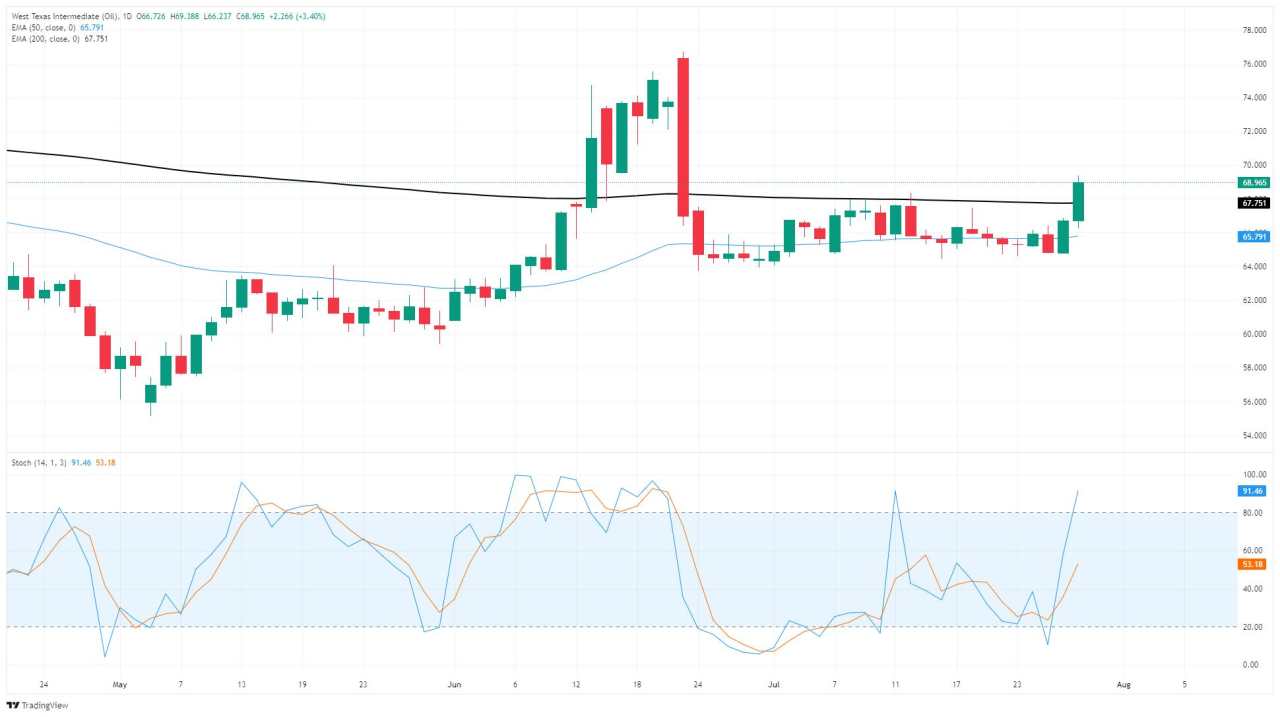- US President Donald Trump gave Russia ten days to figure out a deal with the Ukraine.
- If Russia doesn't play ball, Trump is threatening new sanctions on Russian Crude Oil.
- Secondary tariffs are on the table as well as Trump threatens to go after anyone who buys Russian barrels.
West Texas Intermediate (WTI) US Crude Oil rose at its fastest single-day pace in over a month after US President Donald Trump announced that he's giving Russia just ten days to reach an acceptable resolution on Ukraine, or face stiff economic sanctions and penalties. The Trump administration is threatening to impose stiff secondary tariffs on any country that purchases Russian Crude Oil assets if a deal isn't reached in the next ten days.
WTI Crude Oil is back above $69.00 per barrel for the first time since late June, rising over 3.5% on Tuesday alone. WTI has risen 7% bottom-to-top over a two-day period as the Trump team ramps up its tough talk against the Russian regime. Donald Trump has pivoted into expressing frustration at Russian President Vladimir Putin, as Putin's lack of earnest peace talks with Ukraine hamper Donald Trump's ability to fulfill his campaign promises of decisively ending the war in Ukraine.
The ongoing Russian invasion within Ukrainian borders has been ongoing for 1.251 days and counting. Russia's government initially expected the entire "military exercise" to take no more than three days, but Russia's military has thus far struggled, if not outright failed, to overcome a country that is roughly one-third the size of Russia.
WTI price forecast
With stiff trade penalties on the docket for energy markets, WTI has jumped into a new price band just north of the 200-day Exponential Moving Average (EMA) near $68.15. Price action has broken through the key moving average for the first time in over a month, and price action is headed back to $70.00/bbl.
WTI daily chart

WTI Oil FAQs
WTI Oil is a type of Crude Oil sold on international markets. The WTI stands for West Texas Intermediate, one of three major types including Brent and Dubai Crude. WTI is also referred to as “light” and “sweet” because of its relatively low gravity and sulfur content respectively. It is considered a high quality Oil that is easily refined. It is sourced in the United States and distributed via the Cushing hub, which is considered “The Pipeline Crossroads of the World”. It is a benchmark for the Oil market and WTI price is frequently quoted in the media.
Like all assets, supply and demand are the key drivers of WTI Oil price. As such, global growth can be a driver of increased demand and vice versa for weak global growth. Political instability, wars, and sanctions can disrupt supply and impact prices. The decisions of OPEC, a group of major Oil-producing countries, is another key driver of price. The value of the US Dollar influences the price of WTI Crude Oil, since Oil is predominantly traded in US Dollars, thus a weaker US Dollar can make Oil more affordable and vice versa.
The weekly Oil inventory reports published by the American Petroleum Institute (API) and the Energy Information Agency (EIA) impact the price of WTI Oil. Changes in inventories reflect fluctuating supply and demand. If the data shows a drop in inventories it can indicate increased demand, pushing up Oil price. Higher inventories can reflect increased supply, pushing down prices. API’s report is published every Tuesday and EIA’s the day after. Their results are usually similar, falling within 1% of each other 75% of the time. The EIA data is considered more reliable, since it is a government agency.
OPEC (Organization of the Petroleum Exporting Countries) is a group of 12 Oil-producing nations who collectively decide production quotas for member countries at twice-yearly meetings. Their decisions often impact WTI Oil prices. When OPEC decides to lower quotas, it can tighten supply, pushing up Oil prices. When OPEC increases production, it has the opposite effect. OPEC+ refers to an expanded group that includes ten extra non-OPEC members, the most notable of which is Russia.
Được in lại từ FXStreet, bản quyền được giữ lại bởi tác giả gốc.
Tuyên bố miễn trừ trách nhiệm: Nội dung trên chỉ đại diện cho quan điểm của tác giả hoặc khách mời. Nó không đại diện cho quan điểm hoặc lập trường của FOLLOWME và không có nghĩa là FOLLOWME đồng ý với tuyên bố hoặc mô tả của họ, cũng không cấu thành bất kỳ lời khuyên đầu tư nào. Đối với tất cả các hành động do khách truy cập thực hiện dựa trên thông tin do cộng đồng FOLLOWME cung cấp, cộng đồng không chịu bất kỳ hình thức trách nhiệm nào trừ khi có cam kết rõ ràng bằng văn bản.
Website Cộng đồng Giao Dịch FOLLOWME: www.followme.asia


Tải thất bại ()